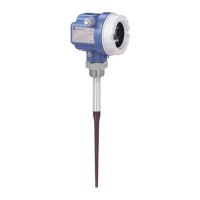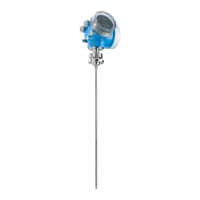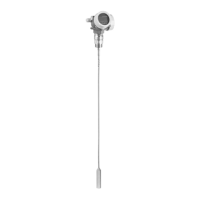7.4 Application parameter
Application parameterThe application parameter that is entered during calibration sets the various elements of
the signal evaluation such that the Micropilot is ideally matched to the application.
Parameters are set in both the operating and the service level.
Table 7.3 summarises the parameters available.
HeightThe height is the principle element in determining the type of tank, the speed of level
changes and the conditions at the product surface. It also affects the mounting position,
which in turn influences on the generation of multiple echoes when the product surface
is calm..
First echo factorThe first echo factor directly affects the signal evaluation and ensures that the level echo
is correctly identified in the presence of multiple echoes. The factor can be set in V3H4
(0: Minimum, 1 = Medium, 2 = Maximum). A central mounting position in the tank, a
domed tank top and a calm product surface all favour the production of multiple echoes.
Tank bottom recognitionThe tank bottom recognition function ensures reliable measurement in the following
cases:
•
The tank has a dished bottom. If microwaves are reflected from the tank bottom,
e.g. when the tank is completely empty, then the curvature causes them to be
deflected towards the tank wall. This results in an increase in the time-of-flight,
and hence of the apparent distance to the level echo. A negative level would be
displayed. The tank bottom recognition function recognises this state of affairs
and displays the level zero.
•
The liquid has a low dielectric constant (Class A and B) and the surface is calm.
Under these conditions a portion of the microwaves penetrate the surface. When
the tank is almost empty, it is possible that these microwaves are reflected from
its bottom to produce a strong, somewhat delayed echo. A negative level would
be displayed. The tank bottom recognition function recognises this state of affairs
and displays the true level.
Code Application Height Change in
level
Product
surface
Mounting First echo
factor
Product
Class
Plausibility
Chapter 7.8
Tank bottom
recognition
0 Tank up to 7 m normal
...25 cm/min
calm to small
waves
non-central maximum C, D off on
1 Tank up to 1.5 m rapid
...50 cm/min
small waves central maximum B, C, D off on
2 Tank up to 7 m normal
...25 cm/min
calm to small
waves
non-central medium B, C off on
3 Tank 7m to 20 m slow
...10 cm/min
calm non-central medium B, C, D off off
4 Stilling well up to 7 m normal
...25 cm/min
calm central medium B, C, D on off
5 Stilling well up to 1.5 rapid
...50 cm/min
calm to small
waves
central maximun B, C, D on off
6 Stilling well 7m to 20 m slow
...10 cm/min
calm central medium B, C, D on off
7 - 9 Service For service only
Table 7.2
Application parameters
Micropilot FMR 231 Chapter 7 Trouble-Shooting
Endress+Hauser 39

